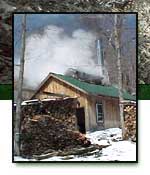Preparation for sugaring season may start as early as January,
stringing or repairing a network of pipelines that runs from
from tree to tree throughout the sugar lots (groves of maple trees
clustered together from decades of forestry management).
As
temperatures moderate in mid to late February, the tapping
process may begin. We start by drilling a hole into the tree trunks, approximately 2-6 feet from the ground. We then drive in either a
plastic spout (to connect to the pipeline collection system) or
a metal spout (from which 12-16 quart buckets with
covers are hung).
The pipelines deliver the sap to storage tubs at the bottom
of the sugar lots, or they may lead directly into the
sugarhouse itself. Sap buckets are emptied by hand
into gathering tanks hauled behind a tractor or truck, and
transported to large stainless storage tanks at the sugarhouse.
Each season our combination of buckets and tubing produces
approximately 30,000 gallons of maple sap – dripping out of the
3000 individual spouts, one drop at a time. The best sap runs occur when the temperatures are low- to mid-20s (F) at night and low- to mid-40s
during the day...the faster the warm up, the better the production of the run.
Maple syrup is produced by boiling the sap at 219 degrees Fahrenheit,
evaporating much of the water. This evaporation process is what produces the tremendous amount of steam that can be seen
billowing from sugarhouses each Spring. On average, it takes approximately 40 gallons
of sap to produce a single gallon of maple syrup.
At Evans Maple Farm, our evaporation
is done over a wood-fired, airtight arch, with fans that burn
the wood at a hotter temperature, increasing the efficiency. The fire in the
arch is drawn through numerous flues in the
back pan, aided by air drafts created by an overly tall chimney stack. Sap
circulates around the vast boiling
surfaces of these flues, on its way to the front pan – where the highest quality maple syrup is drawn off, strained and
processed into various size containers.
When syrup is the proper density, it weighs 11 pounds a gallon.
If stored in a cool dry place and out of direct sunlight, it will last for years. Once the seal is broken, the syrup must
be refrigerated. If it is not, and it molds, all you need to do is to bring the
syrup to a boil and skim
it, thereby restoring it to its original delicious flavor. (Warning: If your pot is too small, the syrup will boil over within seconds,
making a terrible mess.)


